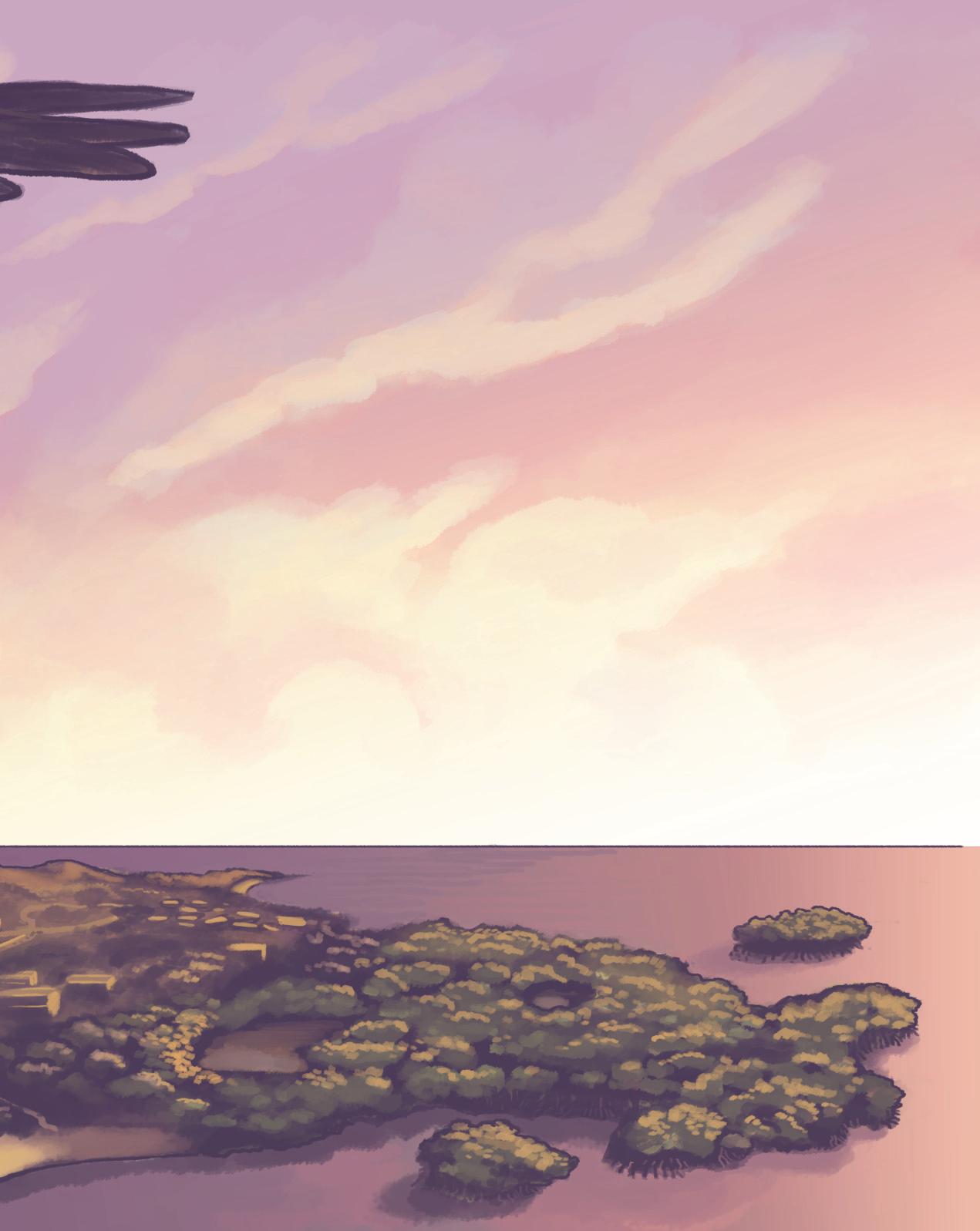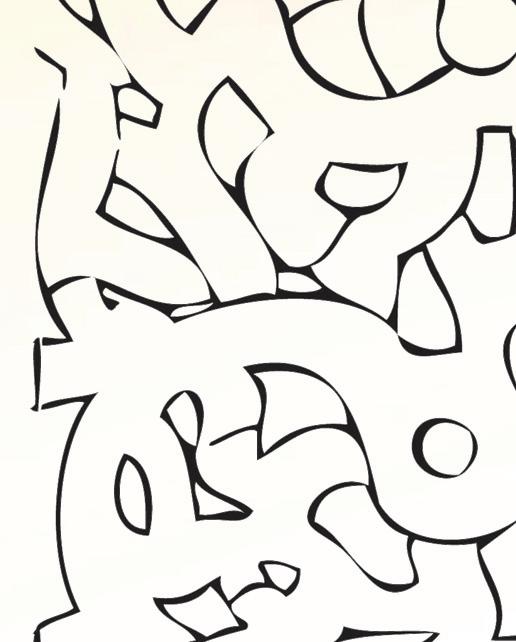
Delmis del C. Alicea Segarra Jorge I. Casillas Maldonado
Ilustrated by: Daniel Irizarri Oquendo


English translation: Wilmarie Cruz Franceschi

Credits
© 2021
Authors
Delmis del C. Alicea Segarra, EdD, Jorge Casillas Maldonado, MS
Collaborators
Ruperto Chaparro, MA, Cris na D. Olán Mar nez, MS, Migdalia Figueroa, BS, Ivonne Bejarano, PhD, Yarleen Irizarry, BS, Johanna Guzmán, BSE y Carmen Zayas San ago, MS
Edi on Delmis del C. Alicea Segarra, EdD, Jorge Casillas Maldonado, MS, Ruperto Chaparro Serrano, MA, Cris na D. Olán Mar nez, MA
English transla on Wilmarie Cruz Franceschi, MA
English edi ng
Lynne M. Hinkey, PhD
Ilustra on Daniel Irizarri Oquendo, BA
Graphic design and layout
Daniel Irrizari Oquendo
Prin ng
Raúl Omar Or z Arroyo, MAG, Delmis del C. Alicea Segarra, EdD
Publishing number UPRSG-E-299
ISBN: 978-1-881719-80-9






Itwas a bright, sunny day. There was a slight breeze, and the waves moved back and forth gently. Life in the mangrove forest was enviously peaceful. Everybody went about their usual daily routines: the pelicans and the frigate birds scouted for sardines and herrings; the yellow warblers, butterflies and bees darted among the flowers; tiny fish searched for food and hid among the red mangrove’s roots to hide from bigger fish like tarpons and barracudas.
The younglings played and Pepe Uca, a young fiddler crab, walked around the wetland, thinking about his life up until that moment. He’d lived his entire life there with his family, among the mangroves, with the birds and the fish. He had plenty of food, a beautiful home, and friends who offered support and affection.

It was a perfect life. And yet, ever since he was little, he had always wondered about life beyond the mangrove forest.

He always asked himself about other places, of what life would be like elsewhere. He felt an inexplicable anxiety and he felt as if something was missing. He needed to feel excitement, have adventures, and live through different experiences that would allow him to discover the world.
That day, while observing the sea, he made his decision.
He spent the rest of the day planning his journey, imagining all the things he would see. At dusk, when everyone else was off resting, Pepe gathered enough food for several days and marched off. He left his mangrove forest, left the familiar salt flats of La Parguera, and began his travels across the southern coast of Puerto Rico. He felt nostalgia as he left everything behind, but he was excited because he would discover new places. The days went by and Pepe marveled at all the things he saw: tall palm trees, huge mountains, the blue sky, an ever-changing sea, and plants and animals he’d never seen before.

—“I’m leaving!” —he firmly said to himself: —“I’ll explore other places and find my destiny.”
In the distance, he could see something that resembled a mangrove forest. However, he would have to cross something to reach it - a flat area with a hard, rough and hot surface.
Several huge, noisy objects went along this surface, moving at great speeds. They scared him, but they could not dampen his adventurous spirit. So he decided to cross as quickly as he could.

He was so scared when those great objects went past him! Nervous and shaking all over, he managed to get to the other side. He stopped for a moment to catch his breath and gather his strength. But while he was resting, he heard footsteps, and a shy voice that said:
“How could you cross that dangerous street, all full of cars? Did you look both ways before you did that?”
Wondering who spoke, Pepe looked around. He was surprised to see a fiddler crab, just like him, who had a scared look on his face.
“Who are you?” asked Pepe.
“My name’s Lulo, and I want to welcome you to my community, the Guayama mangrove forest! I saw you crossing the street! Are you crazy? I tried to cross it a while ago, and I almost got run over. I am so scared, I never even leave this place anymore.”
Pepe gave him an astonished look and said:
“Why wouldn’t you ever try to leave? What a coward! You just need to be careful. You know what? You should come with me. It’s always good to share experiences with a friend.”
Lulo thought for a while, and decided that it’s not every day that one meets a bold and fun character like Pepe, and he decided to accompany Pepe on his trip.

Thus, Pepe and Lulo became traveling companions. They crossed several mangrove forests and, when moving across Las Cabezas de San Juan, in Fajardo, Lulo saw a dog approaching them quickly and yelled:
“Mommy! Mommy! Mommy! Mommy!”
“What’s wrong? Where’s your Mommy?”
Pepe shouted.
“No, it’s that dog! It’s coming straight for us! It wants to eat us!” Lulo replied.

“Quick! Let’s hide between the mangrove roots! Come on!” Pepe exclaimed.
Once the danger was past, they resumed their journey, crossing the towns of Luquillo, Río Grande, Canóvanas and Carolina.
They attempted to cross the tarmac in the Luis Muñoz Marín International Airport and, just when they were right in the middle of it, they felt a loud roar that stunned them.
It was a departing plane, and it made so much noise and wind that it pushed the fiddler crabs over to the Isla Verde Beach.
There was a festival going on, and there were so many people dancing to the music that Pepe and Lulo nearly got stepped on. They hid under a trashcan, and had to wait until nightfall to resume their journey.

Then, they reached the San Juan Bay Estuary. They were astonished at how big the estuary was.
“WOOOW! Look at all those buildings, boats, cars and noise in this place! I’ve never seen anything like it!” Pepe exclaimed.
“And did you see how many tourists are visiting?” Lulo asked.
“I heard someone say that there used to be a lot more trees, right where those hotels are now,”
he added, in a thoughtful tone of voice.
They were tired, and felt lost. Suddenly, they heard someone offering directions in a voice tinged with a foreign accent. It was a travelling iguana, with cool sunglasses and everything. The iguana had been observing the fiddler crabs and thought:
“Even though I usually eat plants, today, I’m in the mood for crab! I’ll lure them out of the mangrove, so they have nowhere to hide. Buahahahahaha!”
“Hey, come here! Are you guys lost? I, the Travelling Iguana, am here to help. I know you need to get to a mangrove forest so you can rest, so I’m going to tell you how to get there. You have to keep going west, towards the sunset. That’s how you get to where you’re going.”

The crabs took the iguana’s advice and continued their travels. The iguana kept an eye on them, following them.
They were already near the northwest corner of the island, having traversed nearly all of Puerto Rico. They were tired and hungry, and needed a safe place to rest. They looked and looked, but could not find an adequate place with food and shelter. They couldn’t find any mangrove forests. Lulo began to cry, feeling sad and desperate.
“Settle down! Help me figure out what to do!”
Pepe exclaimed.
Lulo felt someone watching them, and his little legs trembled. Suddenly, something jumped on them, making them run in panic. It was the iguana, who decided it was dinnertime. While running away, the fiddler crabs reached the beach, but could not find anywhere to hide.

A huge wave crashed over them and dragged them out to sea!
Lulo screamed: “Help! Help me! Mommyyyyyy!”
Meanwhile Pepe, exhausted, tried to fight the current but it was so much stronger than him.
Then, he remembered his family and his home. There, he had shelter, food, and the waters were peaceful.
Now, he was in an unfamiliar place, there wasn’t any of the mangrove’s comforting shade, and to top it all off, the sea current was taking him out to deep waters,

along with a friend who would not stop shouting.
Just as they were losing hope, they felt something pull them out of the water.
It was Mulato, a ghost crab who had seen the fiddler crabs out on the beach.
“What are you two doing so far from home?” he asked.
“I have seen other crabs like you, and they weren’t so lucky.”
The adventurers replied, “We left our mangrove forests hoping to find new and better

places to live. However, all we found was the opposite of that!”
Then, Mulato, who was a very wise old crab, told them:
“You have to get back home. There, you have everything you need to have a healthy life. This place doesn’t have the appropriate conditions for crabs like you. The waves here are too strong and won’t let mangrove forests develop. However, not all of it was bad. You managed to find one of life’s most precious gifts:


… friendship.”
A brown booby swooped past. This is a common bird along Puerto Rico’s coasts. Mulato called the booby over.
The Booby got near, and Lulo got scared, but she asked him to calm down and not be afraid.
Mulato asked the Booby if she would help his new friends and take them back to their mangrove homes. The fiddler crabs climbed onto the Booby and said goodbye to Mulato. They were happy, since they were alive and well, and headed towards their most precious treasure
… their home.
The End

Name: ____________________________

University of Puerto Rico
Mayagüez Campus
Sea Grant Program
Mangroves
Date: ____________________________




Professor: _________________________ Grade-Group: ______________________
Instructions: Carefully observe the following labyrinth and help Boba find Pepe and Lulo’s home. Draw a line through the . Then, write a short story describing their voyage as they return home by crossing western Puerto Rico.


Boba, Pepe and Lulo’s Journey Back Home Across Western Puerto Rico
Use the space provided to write a short story describing Boba, Pepe and Lulo’s journey back home across western of Puerto Rico. ______________________________________________ ______________________________________________ ______________________________________________ ______________________________________________ ______________________________________________ ______________________________________________























